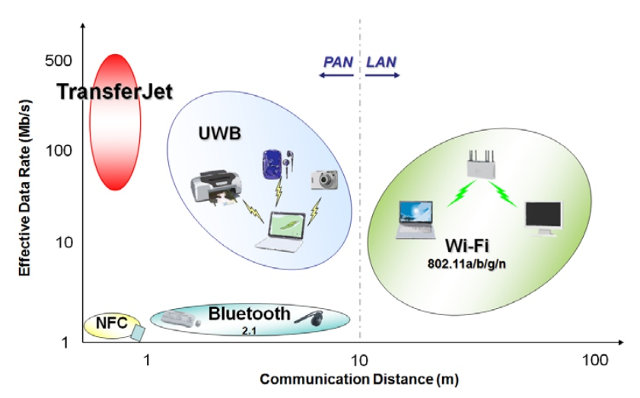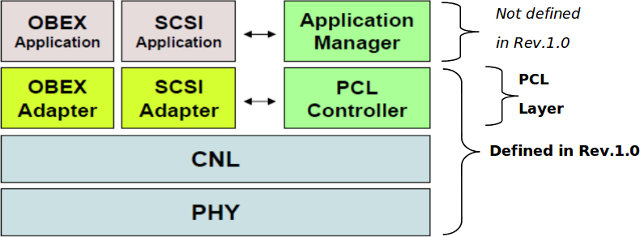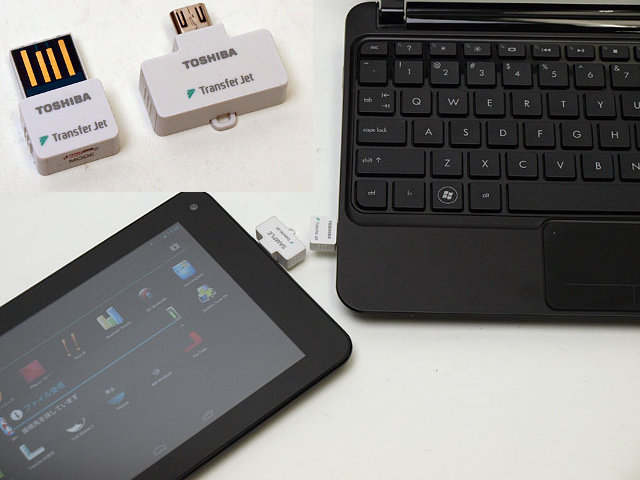 Today, our devices communicate between each others wirelessly thanks to standards such as Wi-Fi, Bluetooth, NFC and more, and the list of Wireless standards is getting bigger as I’ve just found out about TransferJet while reading an article about a new Toshiba ultra-small wireless chip for smartphone. TransferJet can transfer data at a peak speed of 560 Mbps, with an effective throughput up to 375 Mbps over a few centimeters, and appears to work in the similar fashion as NFC, except it’s focusing on large file/data transfers (no payment), and is much faster, about a 1000 times faster actually, as the latter is limited to 424 kbit/s. In real-time benchmarks, it has also been shown to be 5x faster than Wi-Fi to transfer a video.
Today, our devices communicate between each others wirelessly thanks to standards such as Wi-Fi, Bluetooth, NFC and more, and the list of Wireless standards is getting bigger as I’ve just found out about TransferJet while reading an article about a new Toshiba ultra-small wireless chip for smartphone. TransferJet can transfer data at a peak speed of 560 Mbps, with an effective throughput up to 375 Mbps over a few centimeters, and appears to work in the similar fashion as NFC, except it’s focusing on large file/data transfers (no payment), and is much faster, about a 1000 times faster actually, as the latter is limited to 424 kbit/s. In real-time benchmarks, it has also been shown to be 5x faster than Wi-Fi to transfer a video.

TransferJet Technology Compared to Wi-Fi, NFC, and Bluetooth 2.1
Here are TransferJet keys specifications:
- Center Frequency – 4.48 GHz
- Transmission Power – At or below -70dBm/MHz (average). Corresponds to low intensity radio wave regulation in Japan, and with local regulations in other countries and regions.
- Transmission Rate – 560 Mbps (max) / 375 Mbps (effective throughput). System can adjust the transmission rate depending on the wireless environment.
- Modulation – Direct Sequence Spread Spectrum (DSSS), π/2-shifted BPSK
- Connection Distance – A few centimeters
- Topology – 1-to-1, Point-to-point
- Antenna Element – Electric induction field coupler
TransferJet can be use for several use cases including:
- File transfer – The user can use his mobile device (smartphone, camera,…) to send (push) and retrieve (pull) files to/from a TV, computer, or signage. For example, you could easily and quickly download a product catalog to your tablet at a store, send your vacation pictures to your TV, or download a city map within seconds at the airport.
- File access and real-time content consumption – A user might access a file system on her/his mobile terminal (such as phone, digital camera, or
camcorder) by placing it on a TransferJet pad connected to a host terminal such as a computer, digital TV, or projector, and control it via a remote control
- Print services – Initiated either from the mobile device or the printer.
TransferJet 1.0 supports two existing protocols: OBEX (OBject EXchange, aka IrOBEX) and SCSI (Small Computer System Interface), and consists of three layers: Physical Layer (PHY), Connection Layer (CNL), and Protocol Conversion Layer (PCL).

The Physical layer (PHY) defines the actual radio, and converts the digital information into an RF signal suitable for transmission across the TransferJet
couplers. The Connection Layer (CNL) manages the connection and data delivery. The Protocol Conversion Layer (PCL) is responsible for converting from an Application’s existing interface standards (such as SCSI or OBEX), and the TransferJet native protocol.
You can find more technical information in TransfetJet Overview – Concept and Technology (PDF).
Several companies are part of TransferJet consortium, but Toshiba and Sony appear to be the most active, with Toshiba recently showcasing TransferJet USB and microUSB dongles, respectively TJ-UA00A and TJ-MA00A, which are said to work with any devices running Android 4.0 and greater, as well as computers or laptops running Windows 7 or 8, and sell for about $38 in Japan.

Further details are available on TransferJet.org, where you may want to watch the introduction video on the main page in order to get a better undertanding of the use cases.

Jean-Luc started CNX Software in 2010 as a part-time endeavor, before quitting his job as a software engineering manager, and starting to write daily news, and reviews full time later in 2011.
Support CNX Software! Donate via cryptocurrencies, become a Patron on Patreon, or purchase goods on Amazon or Aliexpress. We also use affiliate links in articles to earn commissions if you make a purchase after clicking on those links.



